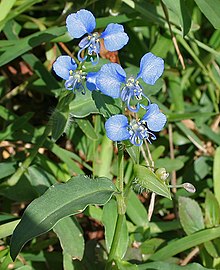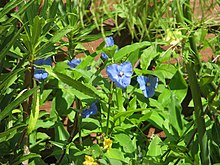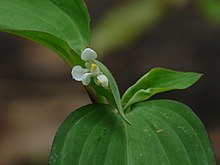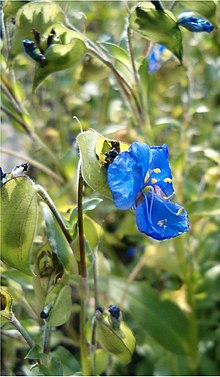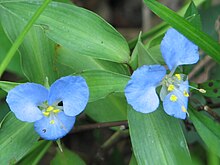Day flowers
| Day flowers | ||||||||||||
|---|---|---|---|---|---|---|---|---|---|---|---|---|
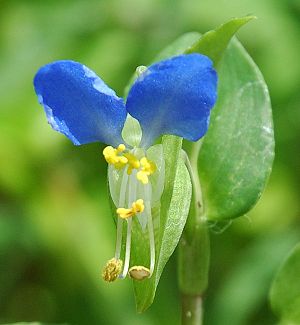
|
||||||||||||
| Systematics | ||||||||||||
|
||||||||||||
| Scientific name | ||||||||||||
| Commelina | ||||||||||||
| L. |

Day flowers ( Commelina ) are a genus in the family of the Commelina plants (Commelinaceae) within the monocot plants . The approximately 200 species are native to the tropics and subtropics.
The genus Commelina is named after the Dutch botanist Jan Commelin (1629 - 1692) and his nephew Caspar Commelin (1668 - 1731). The botanist Charles Plumier named this genus in honor of the Commelins. Carl von Linné later adopted this name.
description
Vegetative characteristics
Commelina species are annual or perennial herbaceous plants . They have fibrous or tuberous roots. The stems are creeping or upright, sometimes thickened like rhizomes, but there are no rhizomes. The alternate two-line or spiral leaves on the stem are sessile or have short petioles.
Generative characteristics
At the end there are one or two zymous inflorescences in a spathe-like bract or two opposite bracts. The clearly stalked, zygomorphic flowers are kleistogamous, hermaphrodite or polygamous , with some flowers then developing exclusively male reproductive organs. The two bract circles are clearly different. The three sepals are free or almost free and are shaped differently from one another, the two outermost are often fused like a hood. The three blue or white colored petals stand free, are shaped differently, whereby the lowest one can be very small, so that it occasionally seems as if it is missing. The top two are nailed to the base and have a significantly enlarged top. Of the six stamens three are fertile (fertile), these have ellipsoidal or saddle-like shaped anthers, the sterile stamens ( staminodes ) are X-shaped. The stamens of all stamens are hairless. The ovary is sessile, hairless, two to dreikammerig with one to two ovules per chamber.
Two to three-fold, dry, popping capsule fruits are formed. The seeds have a smooth surface or are provided with various types of markings, they have a straight hilum (germination point).
The basic chromosome number is x = 11 to 15.
Systematics
The genus Commelina belongs to the tribe Commelineae in the subfamily of Commelinoideae within the family of Commelinaceae . The genus name Commelina was 1753 Linnaeus in Sp. Pl. , 1, p 40 first published . Lectotype is Commelina communis L. Synonyms for Commelina L. are Athyrocarpus Schltdl. ex Benth. , Commelinopsis Pichon , Phaeosphaerion Hassk.
The genus Commelina includes the following species:

- Commelina acutispatha De Wild.
- Commelina acutissima Urb.
-
Commelina africana L. . With the subspecies and varieties:
- Commelina africana subsp. africana
- Commelina africana var. Glabriuscula (Norl.) Brenan
- Commelina africana var. Karooica (CBClarke) Govaerts
- Commelina africana var. Krebsiana (Kunth) CBClarke
- Commelina africana var. Lancispatha C.B.Clarke
- Commelina africana var. Milleri Brenan
- Commelina africana var. Villosior (CBClarke) Brenan
- Commelina africana subsp. zanzibarica thread : It was first described in 2012 from Kenya and Tanzania.
- Commelina agrostophylla F. Muell.
- Commelina albescens Hassk.
- Commelina albiflora thread
- Commelina amplexicaulis Hassk.
- Commelina andamanica S.M. Joseph & Nampy : It was first described in 2014 by the Andamans, the Nicobar Islands and southwestern India.
- Commelina appendiculata C.B. Clarke
- Commelina arenicola thread
- Commelina ascendens J.K. Morton
-
Commelina aspera G. Don ex Benth. . With the varieties:
- Commelina aspera var. Aspera
- Commelina aspera var. Opulens (CBClarke) thread : It was first described in 2012 from tropical Africa.
- Commelina attenuata K.D. Koenig ex Vahl
- Commelina aurantiiflora Faden & Raynsf.
- Commelina auriculata flower
- Commelina avenifolia J.Graham
- Commelina badamica Nandikar & Gurav : It wasfirst describedin 2015 from the Indian state of Karnataka .
- Commelina bambusifolia Matuda
- Commelina bambusifolioides Matuda
- Commelina bangii Rusby
- Commelina barbata Lam.
- Commelina beccariana Martelli
- Commelina bella Oberm.
- Commelina benghalensis L.
- Commelina bequaertii De Wild.
- Commelina boissieriana C.B. Clarke
-
Commelina bracteosa Hassk. . With the subspecies and varieties:
- Commelina bracteosa subsp. bracteosa
- Commelina bracteosa var. Lagosensis (CBClarke) thread : It was first described from Africa in 2012.
- Commelina bracteosa subsp. rhizomifera thread : It was first described in 2012 from Zaire, Tanzania, Angola and Zambia.
- Commelina bravoa Matuda
- Commelina cameroonensis J.K. Morton
- Commelina capitata Benth.
- Commelina caroliniana Walter
- Commelina catharinensis Hassemer, JPRFerreira, Funez & JDMedeiros : It was first described from Brazil in 2016.
- Commelina chamissonis Klotzsch ex CBClarke
- Commelina chayaensis thread : It was first described from Tanzania in 2012.
- Commelina ciliata Stanley
- Commelina clarkeana K. Schum.
- Commelina clavata C.B. Clarke
- Commelina clavatoides Nampy & SMJoseph : She wasfirst describedin 2012 from the Indian state of Kerala .
-
Commelina communis L. . With the varieties:
- Commelina communis var. Communis
- Commelina communis var. Ludens (Miq.) CBClarke
- Commelina congesta C.B. Clarke
- Commelina congestipantha López-Ferr.
- Commelina corbisieri De Wild.
- Commelina corradii Chiov. ex Chiarugi
- Commelina crassicaulis C.B. Clarke
- Commelina cufodontii Chiov.
- Commelina cyanea R.Br.
- Commelina dammeriana K. Schum.
- Commelina dekindtiana Fritsch
- Commelina demissa C.B. Clarke
-
Commelina dianthifolia Redouté . With the varieties:
- Commelina dianthifolia var. Dianthifolia
- Commelina dianthifolia var. Longispatha (Torr.) Brashier
- Commelina dielsii Herter
-
Commelina diffusa Burm.f. . With the subspecies and varieties:
- Commelina diffusa subsp. diffusa
- Commelina diffusa var. Gigas (Small) thread
- Commelina diffusa subsp. montana J.K. Morton
- Commelina diffusa var. Parva Kayama : It was first described in 2017 from the Nansei Islands .
- Commelina diffusa subsp. violacea thread
- Commelina disperma thread
- Commelina droogmansiana De Wild.
-
Commelina Eckloniana Kunth . With six subspecies. It was first described from Africa in 2012.
- Commelina eckloniana subsp. claessensii (De Wild.) Faden
- Commelina eckloniana subsp. critica (De Wild.) Faden
- Commelina eckloniana subsp. echinosperma (K.Schum.) thread
- Commelina eckloniana subsp. eckloniana
- Commelina eckloniana subsp. nairobiensis (thread) thread
- Commelina eckloniana subsp. thikaensis thread
- Commelina elliptica Kunth
- Commelina ensifolia R.Br.
-
Commelina erecta L. . With the subspecies, varieties and forms:
- Commelina erecta var. Angustifolia (Michx.) Fernald
- Commelina erecta var. Deamiana Fernald
- Commelina erecta f. dielsii (Herter) Bacig.
- Commelina erecta subsp. erecta
- Commelina erecta f. hamipila ( C. Wright ex Sauvalle) Brashier
- Commelina erecta subsp. livingstonii (CBClarke) JKMorton
- Commelina erecta subsp. maritima (JKMorton) JKMorton
- Commelina erecta f. roseopurpurea (Herter) Bacig.
- Commelina fluviatilis Brenan
-
Commelina foliacea Chiov. . With the subspecies:
- Commelina foliacea subsp. amplexicaulis thread
- Commelina foliacea subsp. foliacea
- Commelina forskaolii Vahl
- Commelina frutescens thread
- Commelina gambiae C.B. Clarke
- Commelina gelatinosa Edgew.
- Commelina geniculata Ham.
- Commelina giorgii De Wild.
- Commelina gourmaensis A. Chev.
- Commelina grandis Brenan
- Commelina grossa C.B. Clarke
- Commelina guaranitica C.B. Clarke ex Chodat & Hassl.
- Commelina haitiensis Urb. & Ekman
- Commelina heterosperma leaf. & Hallb.
- Commelina hirsuta (Wight) Bedd.
- Commelina hispida Ruiz & Pav.
- Commelina hockii De Wild.
- Commelina holubii C.B. Clarke
- Commelina homblei De Wild.
- Commelina huillensis Welw. ex CBClarke
- Commelina humblotii H.Perrier
- Commelina huntii M. Pell. : It was first described from Brazil in 2017.
- Commelina imberbis Honorary Officer ex Hassk.
- Commelina indehiscens E.Barnes
- Commelina irumuensis De Wild.
- Commelina jaliscana Matuda
- Commelina jamesonii C.B. Clarke
- Commelina kapiriensis De Wild.
- Commelina kilanga De Wild.
- Commelina kisantuensis De Wild.
- Commelina kitaleensis thread : It was first described from Kenya in 2012.
- Commelina kituloensis thread
- Commelina kotschyi Hassk.
- Commelina lanceolata R.Br.
-
Commelina latifolia Hochst. ex A.Rich. . With the varieties:
- Commelina latifolia var. Latifolia
- Commelina latifolia var. Undulatifolia thread
- Commelina leiocarpa Benth.
- Commelina littoralis M.C. Naik & Nandikar : It was first described by the Andamans in 2019.
- Commelina longicapsa C.B. Clarke
- Commelina longicaulis Jacq.
- Commelina longifolia Lam.
- Commelina loureiroi Kunth
- Commelina lukei thread
- Commelina lukonzolwensis De Wild.
- Commelina luteiflora De Wild.
- Commelina luzonensis Elmer
- Commelina macrospatha Gilg & Ledermann ex Mildbr.
- Commelina macrosperma J.K. Morton
- Commelina maculata Edgew.
- Commelina madagascarica C.B. Clarke
- Commelina major H.Perrier
- Commelina martyrum H.Lév.
- Commelina mascarenica C.B. Clarke
- Commelina mathewsii (CBClarke) Faden & DRHunt
- Commelina melanorrhiza thread
- Commelina membranacea Robyns
- Commelina mensensis Schweinf.
- Commelina merkeri K. Schum.
- Commelina microspatha K.Schum.
- Commelina milne-redheadii thread
- Commelina minor Y.N. Lee & YCOh
- Commelina modesta Oberm.
- Commelina montigena H.Perrier
- Commelina mwatayamvoana P.A. Duvign . & Dewit
- Commelina neurophylla C.B. Clarke
-
Commelina nigritana Benth. . With two subspecies that were first described from Africa in 2012:
- Commelina nigritana subsp. aggregata thread
- Commelina nigritana subsp. nigritana
- Commelina nivea López-Ferr., Espejo & Ceja
- Commelina nyasensis C.B.Clarke
- Commelina obliqua Vahl
- Commelina oligotricha Miq.
- Commelina orchidophylla thread & Layton
- Commelina paleata Hassk.
- Commelina pallida Willd.
- Commelina pallidispatha thread : It was first described from Tanzania in 2012.
- Commelina paludosa flower
- Commelina petersii Hassk.
- Commelina phaeochaeta Chiov.
- Commelina platyphylla Klotzsch ex Seub.
-
Commelina polhillii thread & MHAlford . With the subspecies:
- Commelina polhillii subsp. kucharii Faden : It was first described in Tanzania in 2012.
- Commelina polhillii subsp. polhillii
- Commelina pseudopurpurea thread
- Commelina pseudoscaposa De Wild.
- Commelina purpurea C.B. Clarke
- Commelina pycnospatha Brenan
- Commelina pynaertii De Wild.
- Commelina quarrei De Wild.
- Commelina queretarensis López-Ferr., Espejo & Ceja
- Commelina quitensis Benth.
- Commelina ramosissima López-Ferr., Espejo & Ceja
- Commelina ramulosa (CBClarke) H.Perrier
- Commelina reflexa Rusby
- Commelina reptans Brenan
- Commelina reticulata Stanley
- Commelina reygaertii De Wild.
- Commelina rhodesica Norl.
- Commelina robynsii De Wild.
- Commelina roensis M.D.Barrett & RLBarrett : It was first described in 2015 from Western Australia.
- Commelina rogersii Burtt Davy
- Commelina rosulata thread & Layton
- Commelina ruandensis De Wild.
- Commelina rufipes Seub.
- Commelina rupestris Nandikar & Gurav : It wasfirst describedin 2018 from the Indian state of Karnataka .
- Commelina rupicola Font Quer ex Emb. & Maire
- Commelina rzedowskii López-Ferr., Espejo & Ceja
- Commelina saxatilis H.Perrier
- Commelina saxosa De Wild.
- Commelina scabra Benth.
- Commelina scandens Welw. ex CBClarke
- Commelina scaposa C.B. Clarke ex De Wild. & T.Durand
- Commelina schinzii C.B.Clarke in TADurand & H.Schinz
- Commelina schliebenii Mildbr.
-
Commelina schweinfurthii C.B. Clarke . With three subspecies. They were first described from Africa in 2012:
- Commelina schweinfurthii subsp. carsonii (CBClarke) thread
- Commelina schweinfurthii subsp. cecilae (CBClarke) thread
- Commelina schweinfurthii subsp. schweinfurthii
- Commelina shinsendaensis De Wild.
- Commelina sikkimensis C.B. Clarke
- Commelina singularis Vell.
- Commelina socorrogonzaleziae Espejo & López-Ferr.
- Commelina somalensis Chiov.
-
Commelina spectabilis C.B. Clarke . With the varieties:
- Commelina spectabilis var. Ramosa C.B. Clarke
- Commelina spectabilis var. Spectabilis
- Commelina sphaerorrhizoma thread & Layton
- Commelina standleyi Steyerm.
- Commelina stefaniniana Chiov.
- Commelina subcucullata C.B.Clarke
- Commelina subscabrifolia De Wild.
- Commelina subulata Roth
- Commelina suffruticosa flower
- Commelina sulcatisperma thread : It was first described from Tanzania in 2012.
- Commelina sylvatica De Wild.
- Commelina texcocana Matuda
- Commelina trachysperma Chiov.
- Commelina transversifolia De Wild.
- Commelina triangulispatha Mildbr.
- Commelina tricarinata Stanley
- Commelina tricolor E. Barnes
- Commelina trilobosperma K.Schum.
- Commelina tuberosa L.
- Commelina umbellata Schumach. & Thonn.
- Commelina undulata R.Br.
- Commelina ussilensis Schweinf.
- Commelina velutina Mildbr.
- Commelina vermoesenii De Wild.
- Commelina virginica L.
- Commelina welwitschii C.B. Clarke
- Commelina wightii Raizada
- Commelina zambesica C.B.Clarke
- Commelina zenkeri C.B. Clarke
- Commelina zeylanica Falconb.
- Commelina zigzag P.A. Duvign. & Dewit
Description of individual species
Commelina benghalensis is creeping and has deep blue petals that narrow at the base. This type of plant can only be grown outdoors in areas with a very temperate climate. Their home is tropical Africa and Asia. Their chromosome number is 2n = 22.
Commelina coelestis is completely hairy. Your home is Central America. Their chromosome number is 2n = 90.
Commelina communis originates from Asia and can be found today in many areas of northern Italy, where it grows rampant in damp places, on canals, hedges and fields, even in gardens. The bracts of the sky-blue flowers are only fused on one side. In Japan this species iscultivatedas a dye plant. The blue dye forms the basic material for dyeing the awobana paper.
Commelina virginica comes from the USA, it also grows wild easily and has bracts that are overgrown like a bag.
swell
- Deyuan Hong & Robert A. DeFilipps: Commelinaceae in the Flora of China , Volume 24, 2000, p. 35: Commelina - Online. (Section description and systematics)
- Robert B. Faden: Commelinaceae in the Flora of North America , Volume 22, 2000: Commelina - Online. (Section description and systematics)
- Walter Erhardt among others: The big pikeperch. Encyclopedia of Plant Names . Volume 2. Verlag Eugen Ulmer, Stuttgart 2008. ISBN 978-3-8001-5406-7
Individual evidence
- ↑ a b c d e f g h i j k l m n o p q r s t u v w Rafaël Govaerts (Ed.): Commelina. In: World Checklist of Selected Plant Families (WCSP) - The Board of Trustees of the Royal Botanic Gardens, Kew . Retrieved March 19, 2020.
- ↑ Lotte Burkhardt: Directory of eponymous plant names . Extended Edition. Botanic Garden and Botanical Museum Berlin, Free University Berlin Berlin 2018. [1]
- ^ GR Proctor: Commelina . In: Pedro Acevedo-Rodríguez and Mark T. Strong (editors): Monocots and Gymnosperms of Puerto Rico and Virgin Islands , In: Contributions from the United States National Herbarium , Volume 52, 2005, pages 157-161.
- ↑ Commelina in the Germplasm Resources Information Network (GRIN), USDA , ARS , National Genetic Resources Program. National Germplasm Resources Laboratory, Beltsville, Maryland.
- ↑ a b Tropicos. [2]








